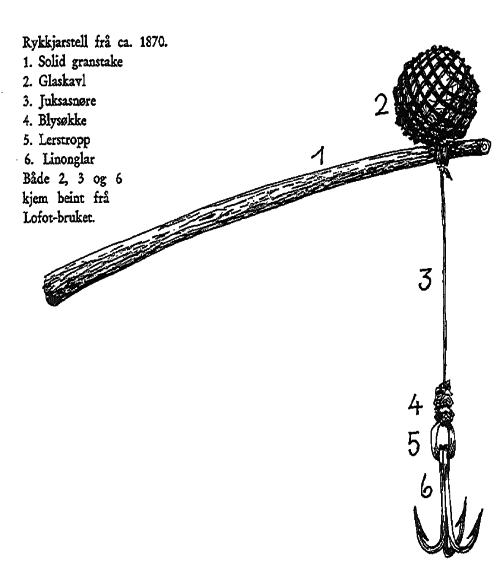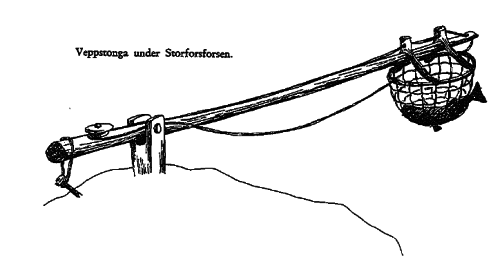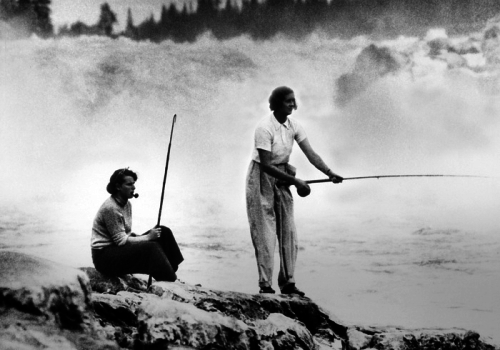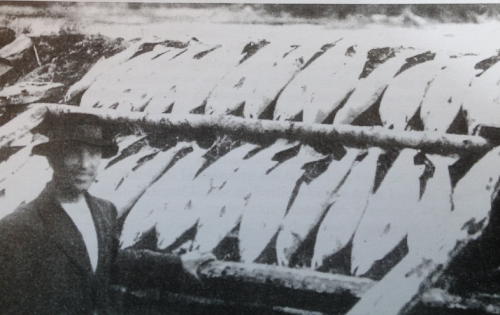The River Vefsn, 125 miles south of the Artic Circle in the county of Nordland, has for a long time been one of Norway`s premier salmon rivers.
Salmon was always something of a staple diet for the people og the Vefns Valley. Traditionally salmon fishing was a way of procuring food and was not, therefore, viewed as a sport. The very abundance of salmon made fishing an effortless task and this in itself discouraged the growth of angling as a sport. The fisk were caught with baited hook, with salmon nets, with sweep nets, or simply by snatching them from under the waterfalls (with rykkjarstell or veppstong. editors Note), where there were salmon in plenty.


Salmon, therefore, was not considered to be a delicacy. Indeed the farm labourers who lived-in on the surrounding farms had a clause written into their contracts which explicitly stated that salmon should not be served at mela times more than three times a week. During the fishing season salmon would be served boiled or fried at dinner time and smoked at other meals. Much of the fish caught was salted in barrels. It would then be served boiled or smoked during the long winter months.
Fishing as a sport was introduced to the Vefsn Valley by English anglers, who began fishing the river about the middle of the nineteenth century. It was they who introduced the method of baiting the hook with prawns and the techniques of using the fly and the spoon.
Few of the farms along the Vefsn Valley own fishing right in the river. Most of the land was originally owned by the Brodtkorb family, and when their Vefsn estates were parcelled out in small farms in the years after 1660 they retained control of the waterfalls and the fishing rights. Today the fishing rights and the fall rights are owned partly by the Norwegian Water and Electricity Board and partly by the Brodtkorb estate.
The best fishing stretches in the Vefsna are at Forsjord and Laksfors. From 1905 to 1963 the annual rent for Forsjord varied between kr. 6.000,- and kr. 10.000,-.
Originally only the lower part of the Vefsna as far as Laksfors was a salmon river. There the waterfall prevented salmon reaching further up-river. At the end of the last century, however, salmon ladders were constructed, thus enabling the fisk to penetrate further upstream. The number of salmon ladders at falls along the Vefsna has steadily increased and several of its tributaries have in this way become good salmon fishing streams.

English female anglers at Laksforsen foto: unknown
The number of salmon caught at Forsjord varied from 350 to 400 in a normal season, to 600 in the record year of 1921. Only salmon weighing more than 8 lbs were counted. In 1921 an English businessman, colonel Cotton, and his rower, Karl Forsjord beat the record for the number of salmon caught in any 24-hour period. Between 10 a.m. and 8 a.m. the following morning they caught 32 salmons.

rower Karl Forsjord with the record catch foto: Cotton
The greatest authority on salmon fishing in the Vefsna was Johan Erlandsen. As a young man he spent many years at sea and during this time learnt to speak fluent English. When he returned to his native valley in 1905 he acted as the intermediary between the local people, tje Norwegian authorities and English anglers. He filled this position for nearby 60 years. He died in 1971 at the age of 90.
Textsource:
Øksendal, K.M. (1971) “Laksefiske i Vefsna. Særtrykk av årbok for NORSK SKOGBRUKSMUSEUM. SKOGBRUK, JAKT OG FISKE. 1967 – 1971” Rønnes trykk, Mosjøen
